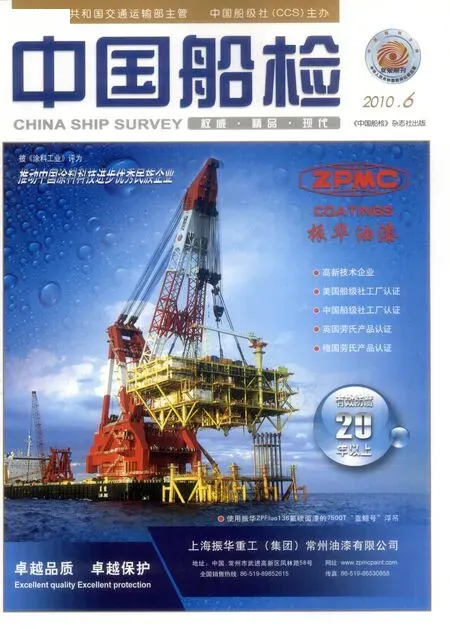人民币升值压力下的船企策略
2010-05-26机械工业信息研究院
机械工业信息研究院 满 颖
人民币升值压力下的船企策略
机械工业信息研究院 满 颖

2010年以来,人民币升值议题随着中国经济的率先复苏再一次被推上了舆论的风口浪尖。美国当地时间4月14日,美国联邦储备委员会主席伯南克在美国国会联合经济委员会作证时表示,美国应该继续就人民币汇率问题向中国施压,这被外界视作迄今针对人民币的最强硬言论。此前,美国总统奥巴马公开表示将在人民币汇率问题上对中国采取更为强硬的立场。在当前造船市场依旧低迷的状况下,如果人民币大幅升值,我国造船业将遭受严重打击。那么,针对这种情况我国船企该如何应对呢?
人民币升值趋势已定
面对愈演愈烈的“人民币即将重返升值通道”的讨论,央行高管日前在各种场合纷纷明确表态,人民币的升值应当是长期、缓慢且逐步的过程。纵观各国经济发展与汇率变动的历史,实际汇率将随着经济发展劳动生产率的提高而趋于升值是一条实证经验,这也是著名的“巴拉萨—萨缪尔森效应假说”。
虽然2009年我国超越德国成为世界第一大出口国,但我国大部分出口商品的利润只有2%~3%。一旦人民币升值,许多行业将毫无利润可言。今年2月,商务部和工信部对劳动密集型行业进行压力测试,以观察人民币汇率的变动将会对各行业造成何种影响。机电商会内部调查报告显示,如果人民币对美元汇率升值,将明显削弱行业企业的国际竞争力,抑制出口。
人民币升值之所以对造船业存在巨大影响,原因在于造船业是典型出口为主行业。2009年我国出口船舶比重近80%,而且我国造船合同结算货币绝大部分用美元,包括国内船东订造海船的合同。造船从报价、签约到合同执行完毕经历时间长,正常情况下2~3年,近期为3~4年,甚至更长。造船合同金额大,一般高达数千万美元、数亿美元,甚至更大。造船合同涉及多种货币,设备采购使用欧元、日元、美元、人民币。
中小船企或现倒闭潮
机电、轻工进出口商会测试结果显示,人民币升值对于短期内的出口利润有较大影响,如果升值过快,行业利润率在短期内将大幅下滑,部分行业甚至面临亏损。
2009年我国船舶进出口总额为308.44亿美元。其中,船舶产品出口累计283.64亿美元,占进出口总额的92%,我国船舶业的出口依存度很高。按照2009年12月31日1美元对人民币6.8282元进行换算,2009年我国船舶出口累计1936.75亿人民币,如果人民币在2010年升值5%,则折合人民币为1839.91亿,两者相减我国船舶出口因为人民币升值损失达96.84亿人民币,而2009年1~11月我国船舶业的利润总额为316.4亿元,人民币升值损失占船舶业2009年度利润的近30%。2009年1~11月我国船舶业的主营业务收入为4080亿元,行业平均利润率为7.8%,人民币升值5%将使利润率下降2.2个百分点。
因为2009年造船业所造船舶大多为2~3年以前所下订单,当时正值船市兴旺期,船价相对较高,人民币升值5%是可以接受的,而现在船价跌了30%~40%,新船的价格基本上是在成本价附近徘徊,如果在这个情况下人民币升值5%,企业将处在盈亏平衡的边缘。
加上受国际原油和铁矿石价格上涨的推动,从2009年12月份开始,我国原材料、燃料和动力价格不断上涨,特别是船用钢材价格一路飙升,给船厂带来很大的成本压力。按目前新船价格测算,钢材成本约占全部造船成本的35%,钢材价格每上涨10%,将增加造船成本3.5%。2010年将是我国造船企业面临生死存亡的关键一年。业内人士分析,汇率升值有可能成为部分中小船舶企业倒闭的催化剂。
造船企业的应对策略
我国造船企业的主要竞争对手是韩国和日本。2009年,日元和韩元对美元持续升值,而人民币相对稳定,这对我国造船企业提高竞争力是有利的。进入2010年,人民币升值呼声越来越强烈,韩元、日元则相对比较稳定。如果中、日、韩三国币种对美元都是升值的,且幅度相近,则人民币汇率升值对我国造船企业的影响相对较小,反之,如果主要造船国家的货币都出现贬值,我国造船企业面临的接单压力将加大。
据统计,今年一季度,韩国船企承接了全球大部分订单,并且基本上都是出口船订单,韩企抢单的秘诀就在于大幅降价,而韩币贬值预期是促使该国降价的重要推动力。目前,我国一些船企订单稀少的一大因素是由于人民币升值预期,而不敢像韩国船企那样接2013年、2014年的大单。
针对这种情况,造船企业对于人民币升值风险要提前防范。造船企业比较可行的方式是利用更多的金融衍生品如外汇期权等来降低汇率风险,目前,我国各出口企业利用金融避险产品规避汇率升值风险的操作还很少。2009年中国出口信用保险渗透率约为9.7%,低于世界平均水平的15%,存在覆盖率低、服务网点少、市场整体承保能力低的特点。我国造船企业要想规避人民币升值风险,首先应争取以非美元货币接单、结算,尤其是对国内船东的订单;其次是采用混合货币,尽量减少美元付款比例,加大前期付款比例;并且要建立风险预警机制,在合同中加入汇率风险共担条款,这也是国外船企面对本币升值普遍优先采用的办法。在此基础上,我国造船企业应与国内银行等金融机构密切合作,合理采用金融工具规避汇率风险,如主动结汇、提前结汇、远期结汇、外汇期权、银行保值等一系列国家外汇政策许可的手段来规避汇率风险,减少汇率损失。
加快船舶建造速度、缩短收款周期,也是减少汇率损失最直接有效的非金融手段。据业内人士透露,目前韩国新造船订单普遍降价幅度在30%以上,其个别船型已达到40%,这对大部分船厂来说,已属于成本价甚至是赔本价。对于有的船厂来说,生产效率与机械化水平高,其成本自然更低一些,而对于技术实力相对较弱的船厂,尤其是中国的一些新兴船厂,在低价竞争中报价恐怕只有亏损。但这种产业结构调整,却对中国造船有益无害。
从造船业的长期发展来看,高附加值、高技术船是当今世界船舶业的制高点,也是竞争的焦点。目前,韩国、日本仍是世界造船工业技术的领先者,而中国在掌握核心技术与高端产品的竞争中,仍处于劣势地位。中国船舶工业要继续发展,还需在技术实力上实现根本性的转型与升级。造船企业应抓住目前国家产业结构调整的有利时机,实现业务结构的重组与调整,实现造船技术的转型与升级,实现我国造船业由大转强,这才是造船企业增强抵御外界因素变动的抗风险能力之本。
Our main competitors of shipbuilding corporations are Japan and South Korea.Japanese yen and South Korea won continued to appreciate against U.S. dollar in 2009 and RMB was relatively stable, which is favorable to our shipbuilding enterprises. Entering into 2010, the voice of RMB appreciation is stronger and stronger while South Korea won and Japanese yen are relatively stable. If the currencies of China, Japan and South Korea are all appreciated to U.S. dollar and the range is close, the influence of the appreciation of RMB to shipbuilding industry will not be very obvious. On the contrary, if the currencies of main shipbuilding countries are all depreciated, the order pressure of our shipbuilding enterprises will be increased signif i cantly.
If the domestic shipbuilding enterprises want to evade the risk of RMB appreciation, firstly they should try to avoid taking orders and settling accounts with U.S.dollar, particularly the orders from domestic ship-owners;secondly is to adopt mixed currencies to reduce the U.S.dollar payment ratio and increase the prepayment ratio;thirdly, they have to build the risk warning system and increase item to share the exchange rate risk, which are the priori measures adopted by foreign shipbuilding enterprises. Based on this, our shipbuilding enterprises should work closely with domestic banks and other financial institutions to use suitable financial tools to evade the exchange rate risk, such as active settlement,early settlement, forward settlement, foreign currency options and bank hedge to evade the risk and decrease the exchange rate losses.
Accelerating the rate of ship construction and shortening the gathering period are the most effective non-f i nancial way to decrease the exchange rate loss. According to industry sources, the price of new orders in South Korea is over 30% cut and some specific ships have reached 40%, which is almost cost price and even at loss for most of shipyards. For some shipyards with high eff i ciency and mechanization, the cost is relatively lower,but for the shipyards with weak technology, particularly the new shipyards in China, will not escape def i cit in lowprice competition. However, this adjustment of industry structure has nothing bad to China shipbuilding.
From the long-term development of shipbuilding industry,the competition is focus on the high value-added and high technology ships, which is also the high ground of global shipbuilding. At present, South Korea and Japan are the leaders in world ship building technology while China is in the inferior position in the competition of core technology and high-end products. The sustainable development of Chinese shipbuilding industry mainly depends on the restructure and upgrade of technology.The shipbuilding enterprises should grasp the favorable opportunity of the national industry structure adjustment to achieve the restructure and adjustment of business structure, the restructure and upgrade of technology and the strengthen of the industry, which is the fundamental way of shipbuilding industry to improve their anti-risk capability to withstand the external change factors.
Shipbuilder’s Strategy under the CNY Appreciation Pressure
By Man Ying
